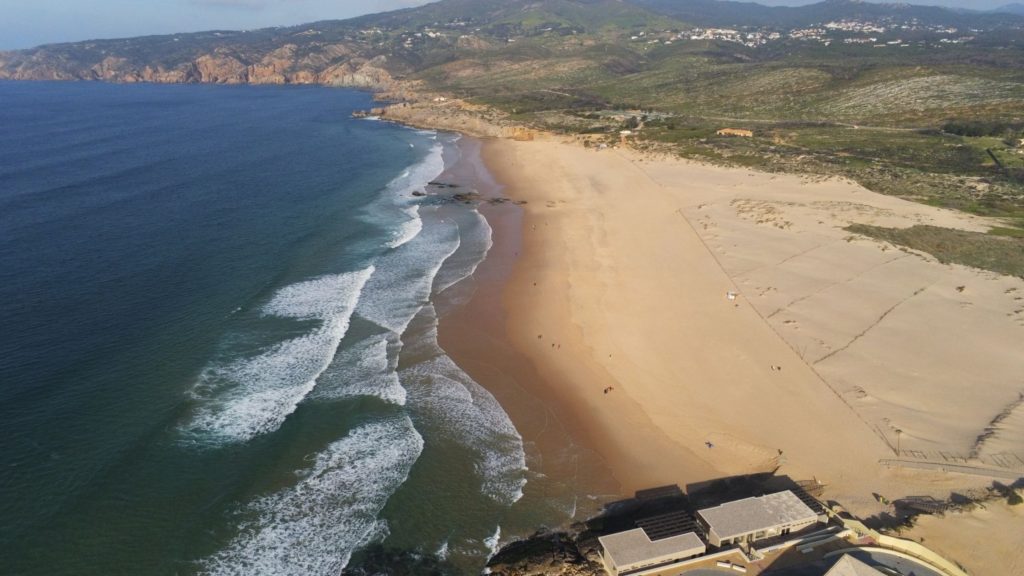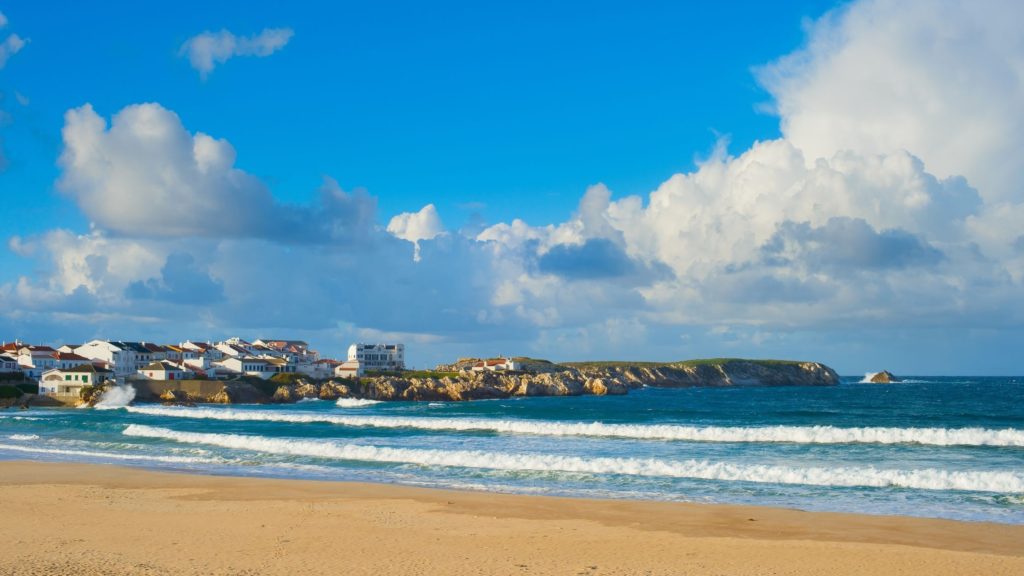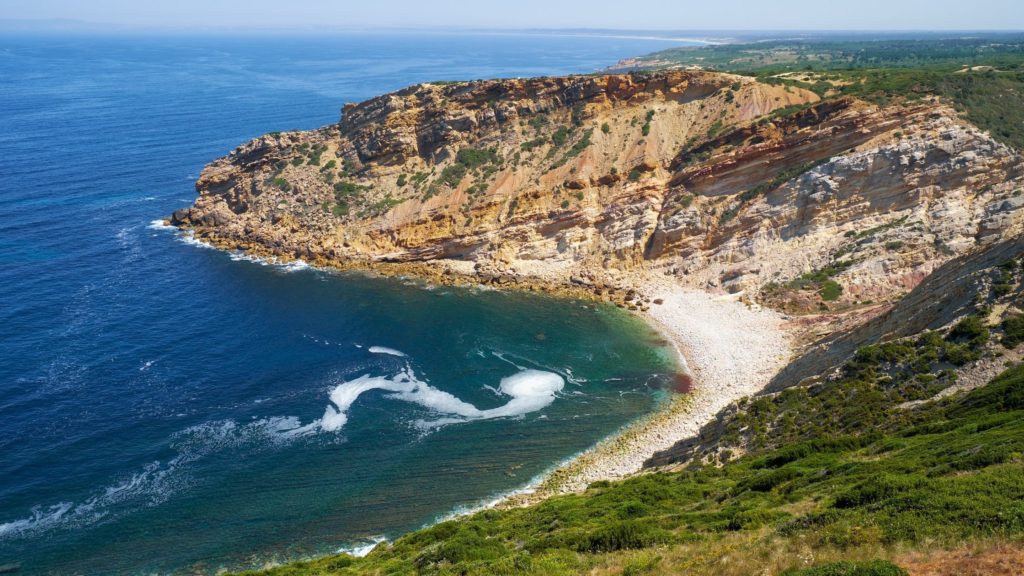Life is a Journey of Escapes is reader-supported. When you buy through links on our site, we may earn an affiliate commission. Learn more
Lisbon, located on the Atlantic Ocean coast, is home to several beautiful beaches within easy driving distance of the Portuguese capital. Several beaches are conveniently located near railway stations, making a day at the beach that much more appealing.
A woman over 50 like you can take a break from touring in the city and find the best spots to explore along this lovely coast. If you’re a beach lover traveling to Lisbon, you’ll definitely love this article. Read on.
10 Most Beautiful Beaches In Lisbon
It’s difficult to choose where to go for a day of sun, sea, and sand because of the diversity of beaches along the many coastlines near Lisbon. Don’t worry; we will go through ten beaches that you must visit!

1. Guincho Beach
This 1km-long beach is located between Cascais and Sintra, in the Sintra-Cascais Natural Park, and is surrounded by dunes and Mediterranean flora. It’s best accessible from Cascais, around 6 kilometers (about 4 miles) away.
It’s noted for its strong winds and waves, which have made it a popular destination for international surfing and windsurfing competitions. It’s best for experienced surfers, however, because of strong currents, individuals with less expertise should go to Carcavelos instead.
2. Carcavelos Beach
There are beaches even closer to Lisbon’s center, but this is the first one that is entirely on the Atlantic. It’s also the largest and now the most popular with young visitors, because of its sports facilities, including sand volleyball and beach soccer. Locals still gather here on weekends, so anticipate crowds.
There are also massage booths and many places to drink and eat during the official bathing season. Certainly, a woman over 50 like you will find comfort and fun here.
3. Praia dos Galapos
If you’re hoping for some peace and quiet, this isn’t the beach for you. Although, this is where you should go if you want a beach with toilets and a place to eat and drink, as well as wicker parasols for shade, a gorgeous environment, and calm, clear waves.
4. Praia da Ursa
The beach at Praia da Ursa is one of Portugal’s most beautiful, yet it is frequently neglected. It’s situated next to Cabo da Roca, making it mainland Europe’s westernmost beach.
It’s wild and pristine since it’s difficult to get there, so those who dare to visit frequently take advantage of the seclusion and sunbathe naked. As a result, it’s an unregistered naturist beach, although you’re welcome to wear your swimming suit and just enjoy the natural beauty.

5. Baleal Beach
Baleal is a wonderful, clean beach popular with both families and surfers. Because of the diversity of the shoreline, there are waves to accommodate all abilities of surfers and all-weather situations.
In addition, this is a beautiful beach with fine white sand and perfect conditions for surfing and bodyboarding. We also encourage sports fishing, motorized sports, aquatic sports, and other activities on this beach.
6. Praia do Figueirinha
Praia da Figueirinha Beach is one of the best-known and most popular in the region, thanks to its picturesque background of the Serra da Arrábida hills, as well as its ease of access and calm waves.
The beach is a stretch of sand that spreads outwards at low tide to form a sandbank, forming a sort of cove that is ideal for windsurfing. During the summer, there is a lifeguard, as well as all of the other facilities you’ll need for a fun family beach day.
7. Adraga Beach
Praia da Adraga is one of the most well-known beaches in the Sintra-Cascais area of Portugal. It has a wide sand beach, a natural setting, and spectacular rock formations.
A steep valley winds down to the beach from this tiny sandy cove, which is bordered by towering cliffs. Also, the beach is normally calmer than the other well-known beaches in the vicinity, and locals mostly use it. However, when parking is scarce, it may get fairly crowded during weekends.
8. Tamariz Beach
Tamariz Beach is situated near the Cascais end of the Lisbon – Cascais line, in the renowned and long-established resort of Estoril. It’s a nice small length of sand with plenty of things to do for people of all ages.
For the youngsters, there are rock pools, and for the rest of us, there are a slew of pubs, cafés, and even a nightclub. A promenade that extends along the coastline from just down the coast to Cascais is suitable for a stroll and is popular with joggers.
In addition, this beach is particularly accessible because a train station is located directly behind it. You’ll reach the beach in no time after passing under the underpass.

9. Ribeira do Cavalo Beach
The treasure trove Praia do Ribeiro Cavalo is located in the Natural Park of “Arrábida,” west of Sesimbra Bay. This beach is one of the most beautiful on the Portuguese coast.
There are two sides to the beach: one with white rocks and pure water, and the other with soft sand. Because there is no reception, it is an ideal spot to really unwind and disconnect, allowing you to thoroughly enjoy the moment and forget about the hustle and bustle of city life. What could be more relaxing than swimming in the cool blue waters while basking in the sun?
It’s also crucial to note that there are no amenities on the beach, so bring everything you need.
10. Alges Beach
Praia de Algés is a city beach with a long sand strip and two pontoons on either side. It’s adjacent to the Centro Nautico de Algés and various quays, and while it’s nice for a sunbath, the main attraction is the ever-changing scenery, which includes a walking and cyclable road, breathtaking views of the sea, the Tejo, and Lisboa, and the renowned VTS Tower.
Honorable Mentions
Praia Grande
Praia Grande is the biggest beach on the Sintra coast, with well-preserved dinosaur footprints on the cliffs and Europe’s largest seawater swimming pool. Even after the official bathing season, it attracts a primarily local, youthful, and sporty audience who surfs or drinks at the seaside bars.
Praia da Califórnia
No, it has nothing to do with the American state, and it’s been reported that this place had this name before the United States was even established. It’s one of two beaches in the heart of Sesimbra’s fishing village, nestled between cliffs and a 17th-century fort.
It may get rather crowded in the summer when it attracts local families, but with so many other beaches closer to Lisbon, it’s not frequently on travelers’ to-do lists. Still, it’s worth considering if you’re planning a long stay in Lisbon, especially if you love tranquil seas and enjoy fresh fish and shellfish.
Meco
Meco is Portugal’s most famous nudist beach, and it’s sheltered by rocks and a pine forest. It’s also one of the most fashionable in the Lisbon region, owing to its restaurant, which has drawn local bohemians for decades. Although the sea is frequently too turbulent for swimming, the dunes and laid-back environment are ideal for a relaxing day in the sun.
Frequently Asked Questions
Can you swim in Lisbon’s seas?
Swimming is permitted in Lisbon, but only in locations where lifeguards are present, as certain beaches have strong currents and concealed rocks beneath the surface. When you arrive, check for the caution flags. Red means you’re not allowed to swim, yellow means you should be cautious when swimming, and green means it’s a nice swimming day.
What’s the water temperature at Lisbon’s beaches?
In the summer, the temperature of the water along the Lisbon coast ranges from 15 to 20 degrees Celsius (60 to 68 degrees Fahrenheit). It’s the Atlantic, not the Mediterranean, and more California than the Caribbean.
Cascais has the warmest beaches, ranging from 17 to 20 degrees Celsius (63 to 68 degrees Fahrenheit). It’s normally around 15°C (60°F) in Sintra, 16°C (61°F) in Costa da Caparica, and between 15°C and 19°C in Arrábida and Sesimbra (60F and 66F). Arrábida is known for having the coldest seas.
When’s the best time to go to Lisbon beaches?
The official swimming season in Cascais is from May 1st to October 15th, whereas it is from June 1st to September 30th in Caparica, and from June 15th and September 15th in Sintra and Arrábida.
Outside of the official season, when there are no lifeguards or sunbeds for rent, you may still enjoy lovely beach days as early as April and as late as late October, when there may be a few wet days, but it still seems like summer.
July and August are the busiest months when many residents go on vacation, and it rarely rains. On the other hand, if you want a bright blue sky without the crowds, late June and early September are the finest dates to visit the beach on the Lisbon coast.
Also, you should avoid going to the beach on a weekend, when the whole city of Lisbon seems to flock to the beach.
Conclusion
You can ensure that your trip isn’t wasted by exploring these ten beautiful Lisbon beaches! Don’t hesitate to seize every opportunity to take a picture of the beautiful oceans around Lisbon. Make sure to enjoy the warm weather and soak in the clear waters on your trip.









No Comments